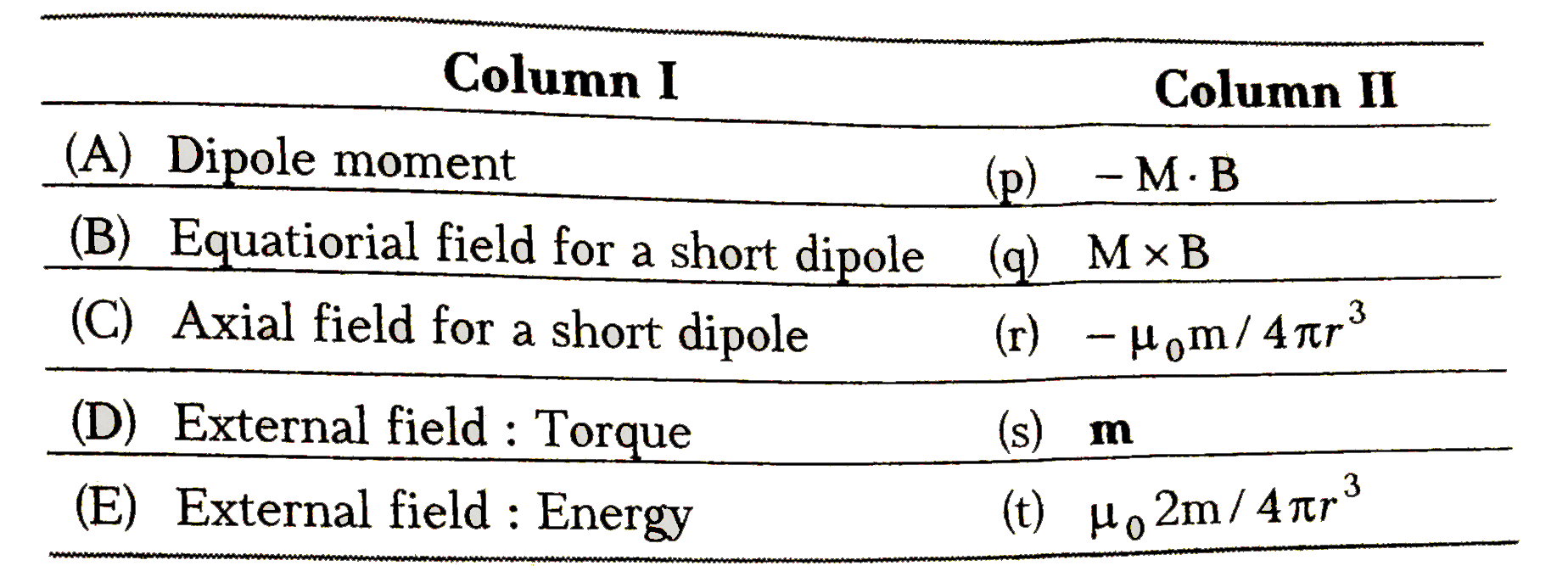Magnetic dipole moment is a vector quantity directed from
sourth to north
north to south
east to west
west to east
The correct Answer is:A
Similar Questions
The product of the length of the magnet and its pole strength is called the moment of a magnet or Magnetic moment. If 'm' is the pole strength and 2l is the length of the magnet then, the moment of the magnet or Magnetic moment is given by. M=m×2l. Also, Magnetic moment is a vector quantity, with its direction from south pole to north pole along its axial line. If a bar magnet of magnetic moment 80 units be cut into two halves of equal lengths the magnetic moment of each half will be
View SolutionWith reference to magnetic dipole, match the tems of Column I with the tems of Column Ii and Choose the correct option from the codes given below.
 View Solution
View Solution
Knowledge Check
- Question 1 - Select One
Magnetic dipole moment is a vector directed from
AS pole to N poleBN pole to S poleCPerpendicular to dipoleDNone of these - Question 2 - Select One
Assertion: Magnetic moment is a vector quantity, whose direction inside the magnet is, from South to North.
Reason: Magnetic lines of force emanate from N-pole and enter into the S-pole.Aboth Assertion and Reason are true and the Reason is the correct explanation of the Assertion.Bboth Assertion and Reason are true but Reason is not a correct explanation of the Assertion.CAssertion is true but the Reason is false.Dboth Assertion and Reason are false. - Question 3 - Select One
Assertion: Magnetic moment of a current loop does not depend on the shape of the loop.
Reason: Magnetic moment is a vector quantity and its direction is perpendicular to its plane.AIf both assertion and reason are correct and reason is a correct explanation of the assertion .BIf both assertion and reason are correct but reason is not the correct explanation of assertion.CIf assertion is correct but reason is incorrect.DIf assertion is incorrect but reason is correct.
Magnetic Dipole Moment || Torque
View SolutionPolar covalent molecules exhibit dipole moment. Dipole moment is equal to the product of charge separation , q and the bond length d for the bond. Unit of dipole moment is debye. One debye is equal to 10−18 esu cm.
Dipole moments is a vector quantity. It has both magnitude and direction. Hence, dipole moment of a molecule depends upon the relative orientation of the bond dipoles, but not on the polarity of bonds alone. A symmetrical structure shows zero dipole moment. Thus, dipole moment helps to predict the geometry of a molecules. Dipole moment values can be distinguish between cis- and trans- isomers, ortho, meta and pare-forms of a substance, etc.
Q. Which is a polar molecule?View SolutionPolar covalent molecules exhibit dipole moment. Dipole moment is equal to the product of charge separation , q and the bond length d for the bond. Unit of dipole moment is debye. One debye is equal to 10−18 esu cm.
Dipole moments is a vector quantity. It has both magnitude and direction. Hence, dipole moment of a molecule depends upon the relative orientation of the bond dipoles, but not on the polarity of bonds alone. A symmetrical structure shows zero dipole moment. Thus, dipole moment helps to predict the geometry of a molecules. Dipole moment values can be distinguish between cis- and trans- isomers, ortho, meta and pare-forms of a substance, etc.
Q. Which is a polar molecule?View Solutiondipole moment is a ............ quantity.
View SolutionPolar covalent molecules exhibit dipole moment. Dipole moment is equal to the product of charge separation , q and the bond length d for the bond. Unit of dipole moment is debye. One debye is equal to 10−18 esu cm.
Dipole moments is a vector quantity. It has both magnitude and direction. Hence, dipole moment of a molecule depends upon the relative orientation of the bond dipoles, but not on the polarity of bonds alone. A symmetrical structure shows zero dipole moment. Thus, dipole moment helps to predict the geometry of a molecules. Dipole moment values can be distinguish between cis- and trans- isomers, ortho, meta and pare-forms of a substance, etc.
Q. Which is a polar molecule?View Solution

